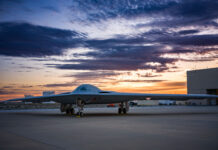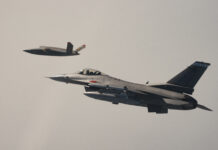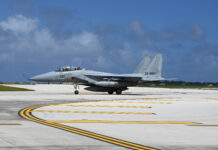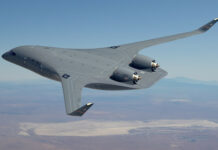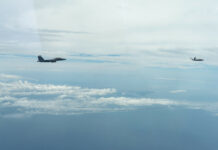The United States Air Force (USAF) is currently developing the Next-Generation Air Dominance (NGAD) tactical aircraft system. The 6th generation NGAD will ultimately replace the 5th generation F-22 RAPTOR as USAF’s primary air-superiority asset.
NGAD is frequently thought of as the next generation fighter aircraft, and even USAF leaders tend to discuss it in such terms. Formally, the Pentagon describes NGAD as a “family of capabilities that enable air superiority in the most challenging operational environments (…) [NGAD] is an advanced aircraft programme for development of penetrating counter-air platforms with multi-domain situational awareness, agile resilient communications, and an integrated family of capabilities.” Space, cyber and electronic warfare elements are expected to integrate into the NGAD system.
Information Drip
Details of the NGAD design, technology and objective capabilities profile remain classified – and will for some time – but the Pentagon has made general statements. The family of systems will include manned and unmanned elements. The manned fighter at the centre of the NGAD system will most likely include the capability to be operated in unmanned mode as well. The aircraft will have greater range and payload capability than the F-22 RAPTOR (no great surprise given widespread criticism of the F-22’s unrefuelled combat radius). Unmanned aircraft carrying additional ordnance and sensors are expected to escort the manned fighter, significantly increasing the combat power of a single flight.
What appears to be a computer screenshot was released in March 2021 as part of the Department of the Air Force’s latest biennial acquisition report, sparking considerable interest. The image depicts a twin-engine blended wing aircraft with an internal weapons bay (all of which would come as no surprise on a 6th generation aircraft which is generally expected to be stealthy in all aspects). Despite initial hopes that USAF might be revealing details of the future fighter’s design, it remains unclear whether the illustration actually represents the current NGAD manned prototype. The image – which depicts alternate engines, landing gear and payloads being interchanged – could simply illustrate the digital design aspect of the development programme. Given USAF’s declared intent to prevent future adversaries from gaining early insights into NGAD, the released image could even be deliberately misleading.
Secrecy notwithstanding, senior leaders have provided some additional insights in recent months. While designed primarily as an air-superiority fighter, the NGAD will have a multirole capability, according to the USAF Chief of Staff, General Charles Q. Brown jr. Testifying before the House Armed Services Committee in June 2021, General Brown explained that this secondary capability would primarily permit the aircraft to defend itself against ground-to-air weapons, but would also provide “options for our air component commanders and for the Joint Force,” implying that the plane could assume ground strike missions if other resources were not available. This would mirror the mission profile of the F-22.
Retired General James Holmes, who led USAF’s Air Combat Command until October 2020, stated in June 2021 that NGAD may eventually incorporate two manned aircraft. One would be optimised for the European theatre of operations. It would presumably be conventionally sized, have a quick turn-around cycle, and be capable of operating from that theatre’s large number of provisional airfields. A larger and heavier variant – with greater range and payload – would be configured for the Indian Ocean/Pacific theatre. In addition to this theatre-oriented difference in requirements, some experts suggest that a larger, multiple-engine aircraft – akin to a light bomber– could be armed with directed energy weapons and patrol a larger segment of airspace in any theatre, augmenting smaller manned and unmanned fighters armed with stand-off range air-to-air missiles.
Peer Player
The new plane will have a prominent role in a shrinking USAF fleet (from 4,000 tactical aircraft at the end of the Cold War, USAF’s fighter force now numbers around 2,000 units). Currently, the US Air Force deploys seven different types of tactical aircraft (including three F-15 variants). Logistical concerns – including simplified expeditionary maintenance – are a major element in USAF’s decision to reduce the future tactical fleet to only four aircraft types. The transition is slated to take place in the 2030s. In addition to the NGAD, the future fleet will encompass:
- the 5th generation F-35 (which will form the backbone of the force)
- the F-15EX (potential procurement of 140-200 aircraft replacing current F-15 variants as a “bomb truck” capable of carrying very large surface-to-surface and surface-to-air payloads)
- the F-16 (USAF intends to upgrade its circa 600 late block aircraft for service through the mid 2040s for multirole operations) or its ultimate low-cost “Generation 4.5″ replacement.
As a 6th generation air superiority fighter, the NGAD is primarily geared to competing with peer and near-peer adversary aircraft. “We need to move beyond just the Russian threat, move beyond just European basic airspace engagement ranges, and beyond 1980s and 1990s technology and defeating a mechanically scanned, single-band sensor,” said General Mark Kelly, head of Air Combat Command, during an August interview with DefenseNews. “So while Russia remains a threat, we now face new adversaries, longer distances in the Asia-Pacific region and a much wider utilization of the electromagnetic spectrum. That requires long-range capabilities that can sense, shoot and thrive in a multispectral environment.”
By engaging enemy air-superiority fighters, NGAD will facilitate operations by US and allied strike aircraft and bombers. In this context, the new fighter’s improved payload and range will be especially valuable for operations in the far-flung IndoPac theatre of operations. In addition to supporting offensive missions, NGAD will defend friendly airspace and installations by engaging enemy strike aircraft at standoff range, optimally before adversaries can launch their own air-ground weapons.
Air Superiority in the Middle East
Despite the direct focus on defeating peer-class (that is, Russian and Chinese) adversaries in the European and IndoPac theatres, introduction of the NGAD will still have significant implications for US military commitments and operations in other regions, especially the Middle East.
Given the current re-focus of some Middle Eastern states to deepen military cooperation with Russia and China, the United States must consider encountering 5th and even 6th generation hardware from those nations. Additionally, should a conflict escalate to a great power war, there is no reason to assume that combat would not expand into the Middle Eastern theatre. In such scenarios, NGAD will be a vital element of US power projection in the region. In case of a more permissive operational environment – sans advanced adversary aircraft – a limited number of NGAD could provide backup for larger contingents of F-35A, F-15EX, and F-16 aircraft. Regardless of theatre, USAF leadership is adamant that the next-generation technology will provide the key to sustained aerial dominance. Without NGAD, they stress, USAF would at some point be unable to retain dominance when facing cutting-edge Russian and Chinese air superiority aircraft.
The e-Series Approach
The NGAD programme utilises advanced digital design and engineering techniques to compare and test complete aircraft concepts in sophisticated simulations, exchanging and adapting individual aircraft components until optimal configurations have been determined. Only then are physical parts manufactured for real world testing (optimal construction and assembly methods for aircraft parts are also developed through simulation, shortening the time needed for physical construction). The Pentagon refers to this development strategy as the “e-Series” approach. It is intended to save both time and money by avoiding dead-end physical prototyping and experimentation.
This approach enabled the NGAD office to build and test fly a full-scale technology demonstrator aircraft only two years after funding for the programme began. The flight test was revealed in September 2020 by Will Roper, who served as Assistant Secretary of the Air Force for Acquisition and Technology until early 2021. The Pentagon has declined to provide further details such as the date of the first flight, the contractor who produced the demonstrator, or whether more than one aircraft has been built; the Air Force did confirm that the plane flew with a full suite of mission systems. Although significant, this event should be taken in context.
While much of the aerospace and defence press referred to the aircraft as a “prototype,” the Pentagon consistently spoke of a “demonstrator.” This latter term implies that the test plane is not necessarily representative of a future production aircraft. USAF’s phrasing even leaves open the possibility that an existing airframe was outfitted with individual NGAD-related technologies to test their viability under flight conditions.
Perpetual Development Spiral?
The digital design revolution also opens up the option of a completely revamped acquisition strategy. Will Roper and others have proposed initiating a nearly continuous development and procurement cycle for NGAD. Rather than purchasing a full fleet of aircraft of the same design, then operating them for 30 or more years, USAF could introduce a new design every few years, and retire “older” airframes after circa 15-16 years of service. Proponents of this strategy cite several advantages. These include significantly reduced operating and maintenance expenses, which would allegedly offset the increased procurement cost. According to Roper, planning a shortened service life could reduce normal sustainment costs by circa 50 percent, eliminate the need for a Service Life Extension Programme (SLEP), and reduce the need for short-term modernization and technology upgrades. A constant development cycle would also ensure that a portion of the fleet would always be at the technological cutting edge. Finally, advocates say that it would permit fielding a fleet optimised for a variety of scenarios. “I don’t think it’s smart thinking to build one and only one aircraft that has to be dominant for all missions in all cases all the time,” Roper stated in 2020. “Digital engineering allows us to build different kinds of airplanes, and if [we] ensure smart commonality across the fleet – common support equipment, common cockpit configurations, common interfaces, common architecture, even common components like a landing gear – that [simplifies] the sustainment and maintenance in the field.”
Lieutenant General Clinton Hinote, USAF deputy chief of staff for strategy, integration and requirements, confirmed in May 2021 that the Pentagon is planning a “perennial spiral” for NGAD development. As one variant enters production, the next generation will already be in the design or even the development phase, Hinote stated during an Air Force Magazine interview. This would ensure continuous maturation and fielding of the newest hardware and software, and provide the full industrial base an opportunity to participate in design and production. Each development cycle could be as short as “every five years, it could be every eight years,” he said.
Whether NGAD ultimately becomes a “traditional” procurement programme or pursues a perennial spiral will be influenced by a number of capabilities and requirements studies currently being conducted. This includes a central Cost Assessment and Programme Evaluation (CAPE) of USAF’s tactical airpower programmes currently being conducted by the Department of Defense. The CAPE is expected to be released by early fall 2021. Results and recommendations are expected to flow into the Fiscal Year 2023 budget request and subsequent year budgets.
Fielding Within the Decade?
Irrespective of the procurement model, NGAD appears to be moving full-speed-ahead. The FY22 defence budget request includes US$1.5Bn for the programme, compared with allocations of US$900M in 2020 and US$1Bn for 2021. These figures include funds for airframe development as well as for next-generation open mission system architecture, advanced sensors and communications, and system integration.
General Hinote stated in May 2021 that retirement of the F-22 will commence circa 2030. This will initially effect the oldest aircraft of that type; newer airframes will be upgraded (mostly with sensors, according to Hinote) and overhauled to retain viability into the 2040s as a bridge to full fielding of the NGAD capability. The general expressed doubt that a Service Life Extension Programme for the F-22 would be necessary, given the swift progress of the NGAD.
This signals strong confidence that NGAD is mature enough for a Low-Rate Initial Production decision in a few years time. This would mesh with General Hinote’s May 2021 statement that by 2030 USAF should be deep into a new cycle of fielding NGAD.





